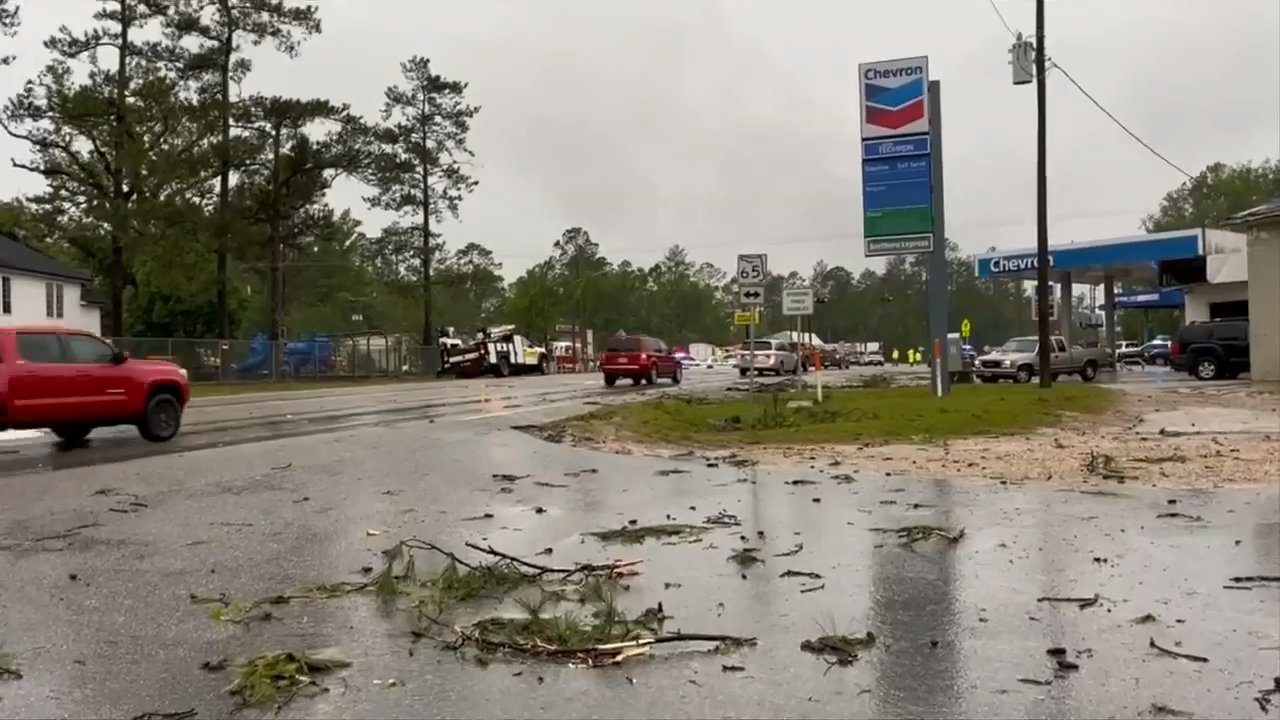Damaging Winds And Fast-Moving Storms: A Comprehensive Guide

Table of Contents
Identifying and Understanding Different Types of Fast-Moving Storms
Fast-moving storms encompass a range of severe weather phenomena, each with unique characteristics and levels of risk. Understanding these differences is key to effective preparation and response.
Tornadoes: Nature's Most Destructive Winds
Tornadoes are violently rotating columns of air extending from a thunderstorm to the ground, characterized by their intense, localized wind speeds. They are arguably the most destructive of all fast-moving storms.
- The Enhanced Fujita Scale (EF-Scale): This scale rates tornadoes based on estimated wind speeds and the damage they inflict, ranging from EF0 (weak) to EF5 (violent and catastrophic). Understanding the scale helps assess the potential severity of a tornado.
- Warning Signs: Recognizing the signs of an approaching tornado is crucial. Look for:
- Dark, greenish-colored sky
- Large hail
- A loud roar, similar to a freight train
- A rotating, funnel-shaped cloud
- Safety During a Tornado Warning: Immediate action is critical. Seek shelter immediately in a sturdy structure, ideally a basement or an interior room on the lowest level. Avoid windows and stay away from exterior walls.
Hurricanes and Typhoons: Powerful Tropical Cyclones
Hurricanes (in the Atlantic and Northeast Pacific) and typhoons (in the Northwest Pacific) are powerful tropical cyclones with sustained winds exceeding 74 mph (119 km/h). These storms are characterized by high sustained winds, torrential rainfall, and the potential for devastating storm surges.
- The Saffir-Simpson Hurricane Wind Scale: This scale categorizes hurricanes based on their sustained wind speeds, indicating the potential for damage. Category 5 hurricanes represent the most extreme threat.
- Warning Signs: Stay informed about impending hurricanes through official weather sources. Warning signs include:
- Storm surge warnings
- Evacuation orders
- Increasing wind speeds and heavy rainfall
- Hurricane Preparedness: Preparation is key to minimizing damage and risk. Steps include:
- Boarding up windows and doors
- Creating a hurricane emergency kit (see below)
- Developing an evacuation plan
Derechos: Widespread Windstorms
Derechos are widespread, long-lived wind storms associated with a band of rapidly moving thunderstorms. Unlike tornadoes, they are characterized by widespread damaging winds rather than a concentrated vortex.
- Derechos vs. Tornadoes: While both cause significant wind damage, derechos cover a much larger area and are associated with straight-line winds, unlike the rotating winds of a tornado.
- Damaging Wind Potential: Derechos can produce sustained winds exceeding 58 mph (93 km/h) and gusts exceeding 75 mph (120 km/h), causing extensive damage to trees, power lines, and structures.
- Safety Tips: During a derecho, seek shelter indoors away from windows. Secure loose objects outside that could become airborne projectiles.
Microbursts and Downbursts: Sudden, Intense Wind Gusts
Microbursts and downbursts are intense localized downdrafts of air that can cause sudden and damaging wind gusts. A microburst is smaller (less than 2.5 miles in diameter), while a downburst is larger.
- Microbursts vs. Downbursts: While both involve intense downdrafts, microbursts are more localized and sudden, making them particularly difficult to predict and prepare for.
- Predictability Challenges: The sudden nature and relatively small size of microbursts make them challenging to predict with precision, emphasizing the need for general severe weather awareness.
- Safety Tips: If caught in a sudden, powerful wind gust, immediately seek shelter indoors, away from windows.
Assessing and Minimizing the Risks of Damaging Winds
Understanding vulnerability and implementing mitigation strategies are critical to reducing the impact of damaging winds.
Identifying Vulnerable Structures
Older buildings, mobile homes, and structures with weak roofs or foundations are particularly vulnerable to wind damage. Proper assessment is crucial for prioritizing mitigation efforts.
Wind Damage Mitigation Techniques
Several techniques can significantly reduce the risk of wind damage:
- Reinforcing Structures: Strengthening roofs, walls, and foundations can improve a building's resistance to high winds.
- Planting Windbreaks: Strategically planted trees and shrubs can help reduce wind speed around structures.
- Regular Maintenance: Regular inspection and maintenance of your property, including roofs, trees, and other structures, can help prevent wind-related damage.
Insurance and Financial Protection
Adequate insurance coverage is essential to protect against the financial consequences of wind damage. Review your homeowner's or renter's insurance policy to ensure it provides sufficient coverage for windstorms and other severe weather events.
Preparing for and Surviving Damaging Winds and Fast-Moving Storms
Proactive preparation is key to ensuring safety during severe weather.
Creating an Emergency Plan
A comprehensive emergency plan is crucial:
- Evacuation Routes: Identify multiple evacuation routes, considering potential road closures.
- Communication Strategies: Establish a communication plan with family members or roommates in case of separation.
- Meeting Point: Designate a specific meeting point in case of evacuation.
Building an Emergency Kit
A well-stocked emergency kit is essential:
- Water: Store at least one gallon of water per person per day for several days.
- Food: Non-perishable, easy-to-prepare food items.
- First-Aid Kit: A comprehensive kit with essential medical supplies.
- Battery-Powered Radio: Stay informed about weather updates.
- Flashlight and Extra Batteries: Essential for navigating during power outages.
Staying Informed During Severe Weather
Reliable information is paramount:
- National Weather Service: The primary source for weather alerts and warnings.
- Local News: Local news channels often provide up-to-the-minute weather reports and emergency information.
- Weather Apps: Utilize reputable weather apps for real-time alerts and forecasts.
Conclusion
Damaging winds and fast-moving storms present a real and ongoing threat. By understanding the different types of storms, implementing effective mitigation strategies, and creating a comprehensive emergency plan, you can significantly reduce your risk and improve your chances of surviving these powerful weather events. Remember to stay informed about impending severe weather through official sources and always prioritize your safety. Take the necessary steps today to prepare for damaging winds and fast-moving storms – your safety depends on it. Invest time in understanding windstorm safety and preparing your home and family for severe weather events. Your proactive approach will be your best defense against damaging winds.

Featured Posts
-
 Manchester Uniteds Fa Cup Victory Fueled By Rashfords Brace Against Aston Villa
May 20, 2025
Manchester Uniteds Fa Cup Victory Fueled By Rashfords Brace Against Aston Villa
May 20, 2025 -
 Hamilton Och Leclerc Diskvalificerade F1 Kaoset Fortsaetter
May 20, 2025
Hamilton Och Leclerc Diskvalificerade F1 Kaoset Fortsaetter
May 20, 2025 -
 The Enduring Appeal Of Agatha Christies Poirot Mysteries
May 20, 2025
The Enduring Appeal Of Agatha Christies Poirot Mysteries
May 20, 2025 -
 Drier Weather Is In Sight What To Expect
May 20, 2025
Drier Weather Is In Sight What To Expect
May 20, 2025 -
 Top 5 Eurovision 2025 Finalists Who Will Win
May 20, 2025
Top 5 Eurovision 2025 Finalists Who Will Win
May 20, 2025
